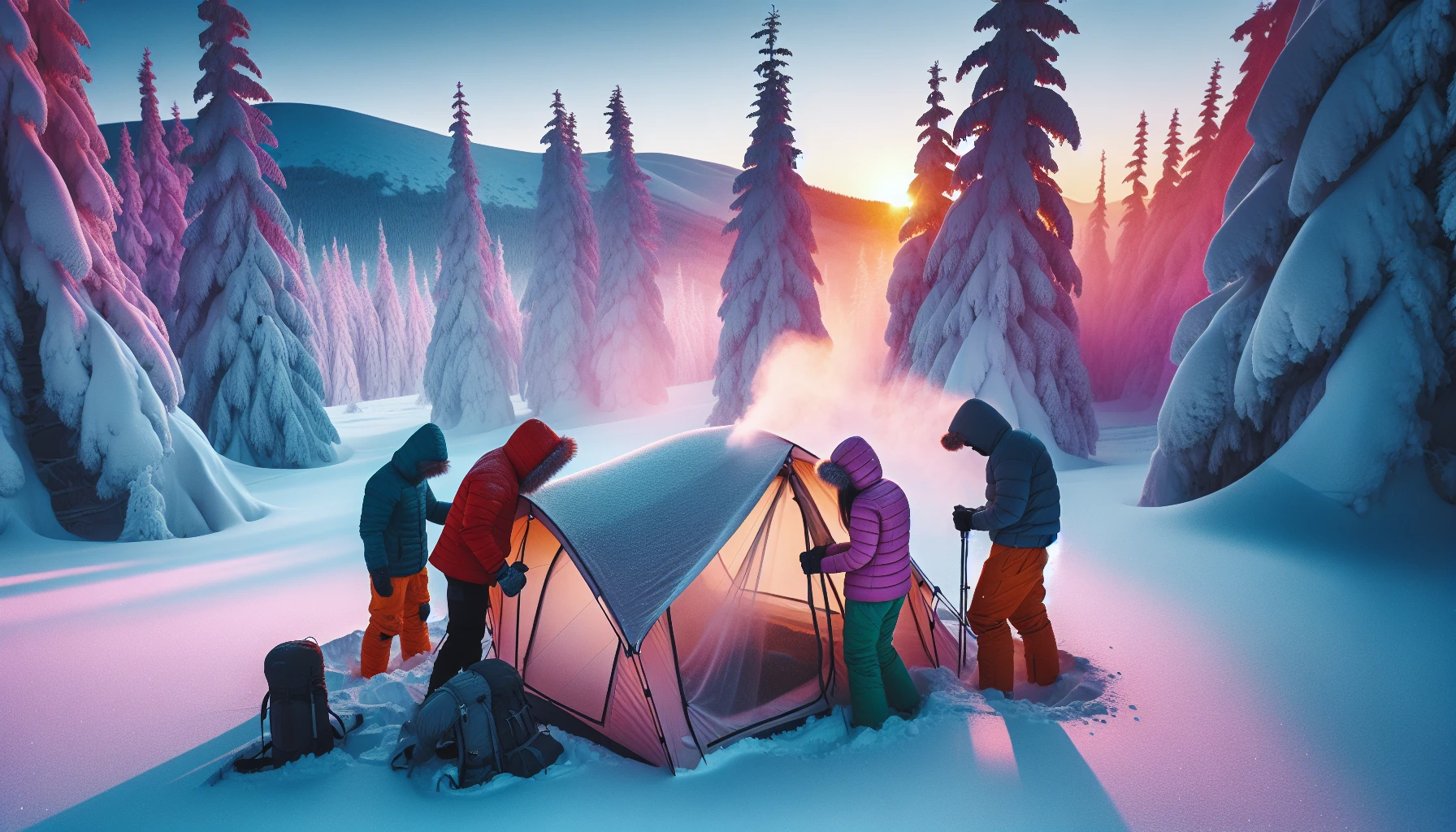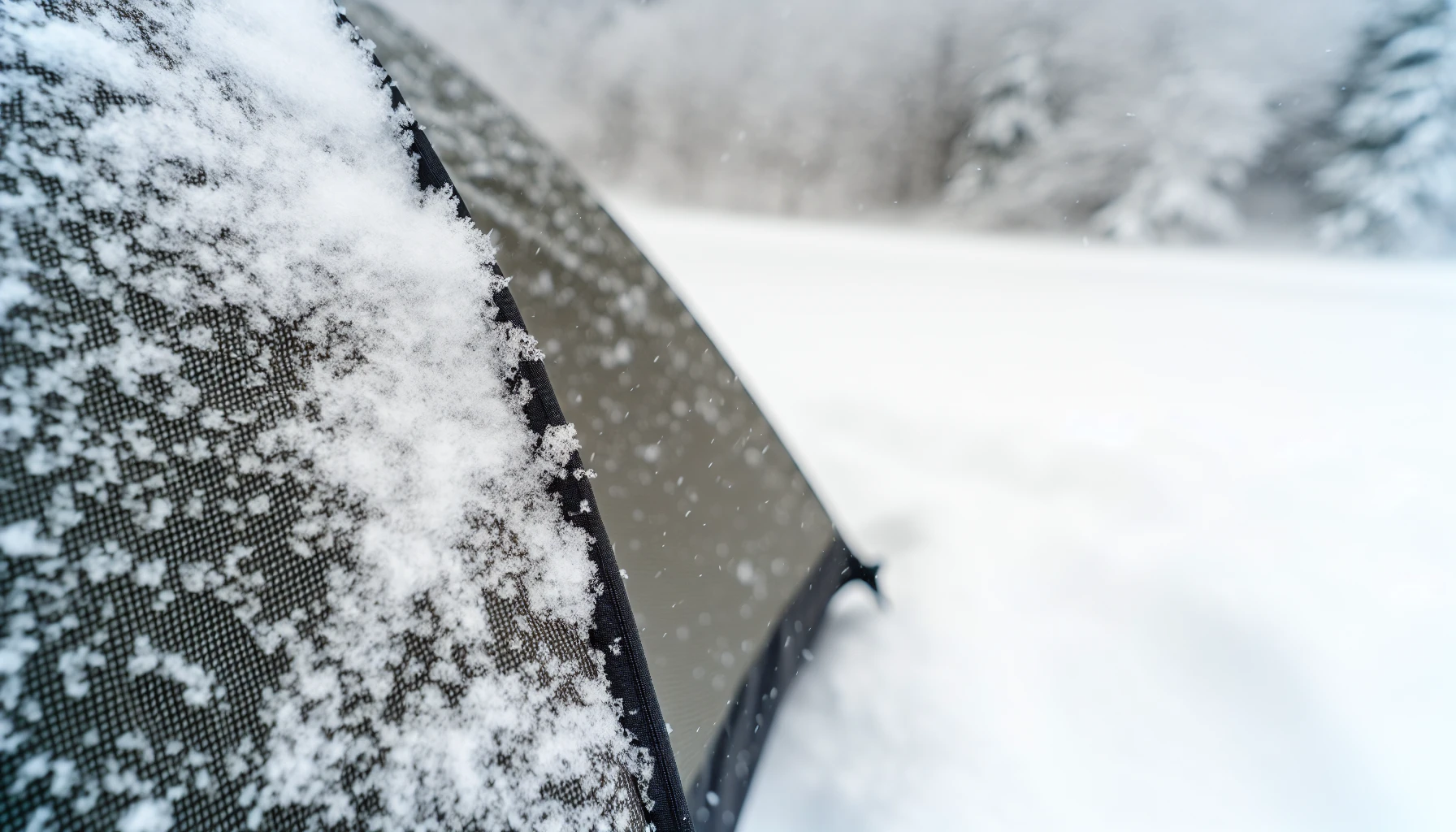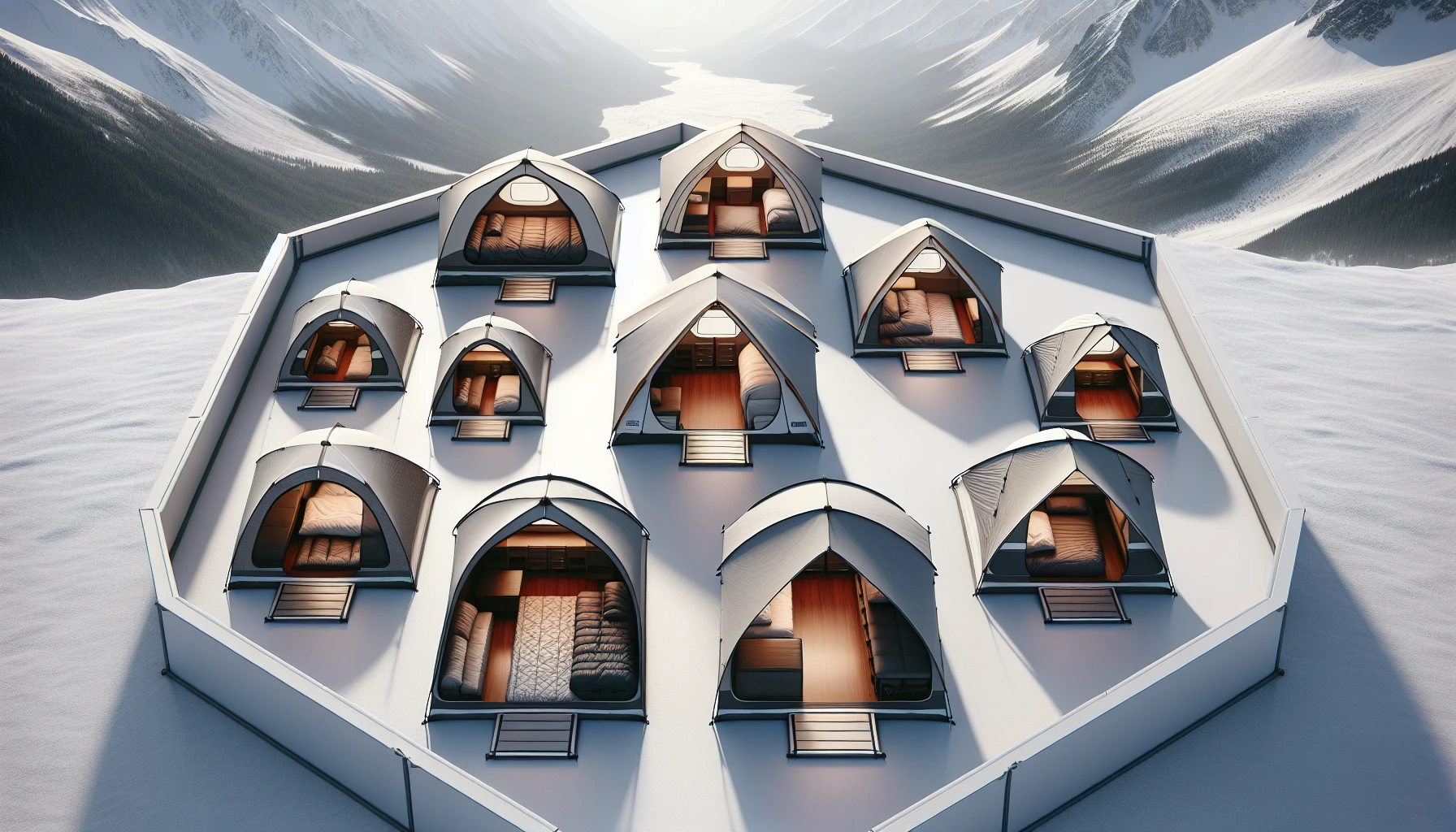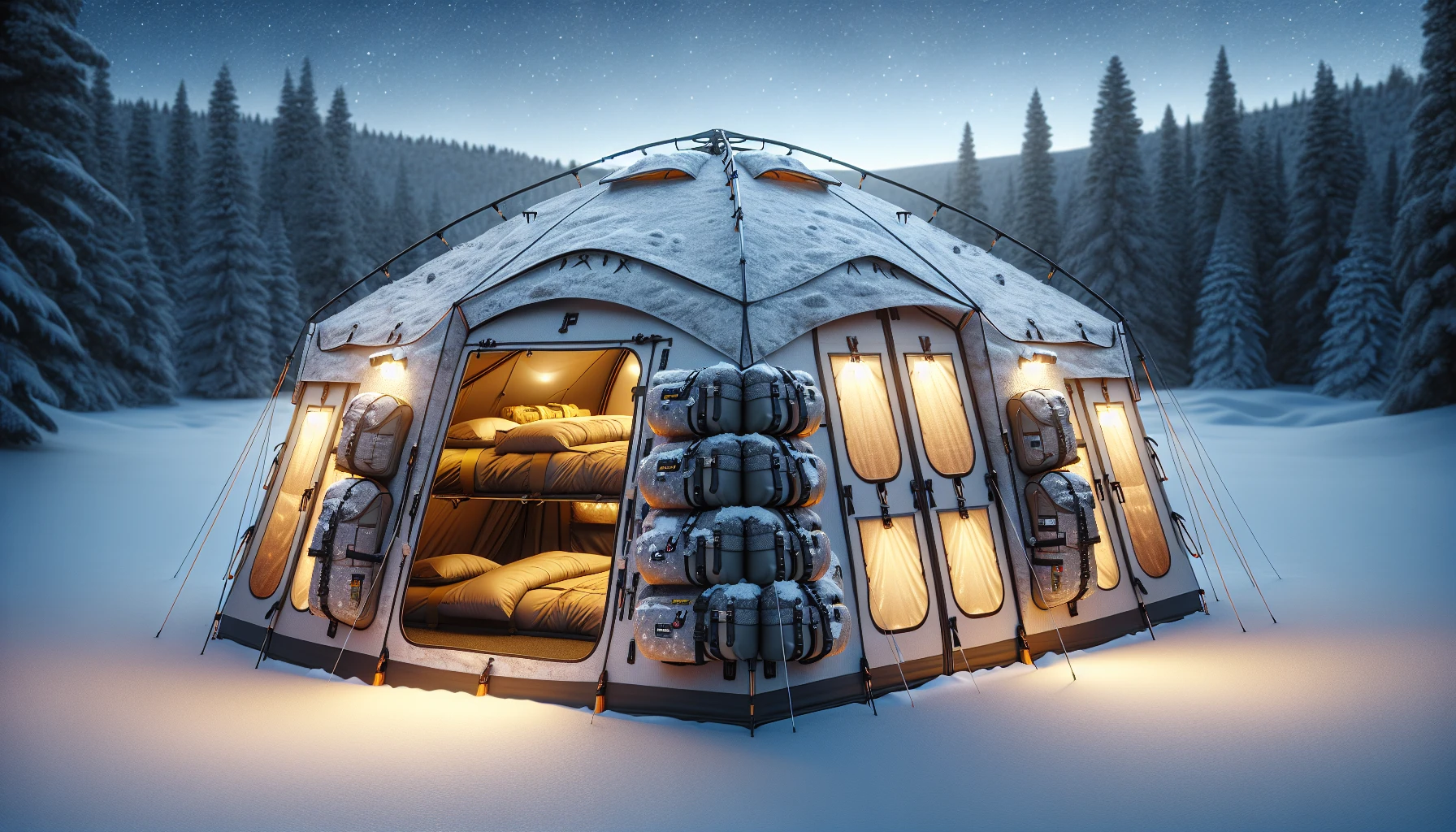Winter camping offers a whole new level of adventure and tranquility, with snow-covered landscapes and peaceful, crisp air. However, to fully enjoy this experience, it is essential to have the right gear, especially when it comes to choosing the perfect tent. In this blog post, we’ll unveil the top 10 winter camping tents designed for various outdoor adventures, from mountaineering to basecamping, ensuring you stay warm and protected in cold weather conditions.
Selecting the right winter camping tent requires taking into account various factors such as the tent’s ability to withstand winter weather, its weight, size, ventilation system, waterproofing, door access, and storage options. Read on to discover the best tents available for your winter outdoor endeavors and the essential features to look for in a reliable and comfortable shelter.
Overview of Remarkable Winter Camping Tents

We’ve evaluated numerous winter camping tents and singled out the top 10 choices for diverse adventure types:
-
Best for Durability – Mountain Hardwear Trango 2
-
Most Popular Choice – The North Face VE 25
-
High-End All-Rounder – Samaya 2.0
-
Ideal for Shoulder-Season Conditions – MSR Access 2
-
Versatile and Affordable – Black Diamond Mega Light
-
Designed for Serious Alpinists – Rab Latok Summit
-
Premium Pick for Extreme Weather – Hilleberg Nammatj 2 GT
-
Strong and Sturdy – MSR Remote 2
-
Lightweight and Compact – Black Diamond HiLight 2P
-
Quick Set-Up and Versatility – Nemo Chogori 2.
The Unbeatable Mountain Hardwear Trango 2
Price: $700
Specifications
-
Double wall tent design
-
40 square feet of tent floor area
-
Two doors and vestibules
Pros:
-
Spacious living area
-
Durable and reliable
-
Suitable for snow camping
Cons:
-
Costlier than some alternatives
-
Heavier than some competitors
The Mountain Hardwear Trango 2, an all-season tent, is notable for its robustness, dependability, and ample living space. It’s a top choice for winter camping, as it is designed to withstand harsh conditions, including high winds and snow. With 40 square feet of tent floor area and a double-wall construction, it provides ample space for you and your gear. Its two doors and vestibules add to the convenience and make it easy to access and organize your belongings.
While the Trango 2 may command a higher price than The North Face VE 25, it compensates with a more durable fly, guaranteeing superior protection against the weather. It’s heavier than the Samaya 2.0, but the additional living space and better breathability make it an excellent choice for snow camping. In conclusion, for those who value durability and comfort in their winter camping shelter, the Mountain Hardwear Trango 2 is a worthy investment.
The North Face VE 25: A Popular Choice
Price: $669
Specifications
-
Double-wall design
-
48-square-foot floor plan
-
Peak height of 48 inches
-
Two doors and vestibules
Pros:
-
Affordable
-
Excellent weather protection
-
Ample storage space
Cons:
-
Slightly less durable fly than Trango 2
-
Not as lightweight as some alternatives
The North Face VE 25 is a widely preferred and budget-friendly option for winter camping. It offers exceptional weather resistance and generous storage space. With its double-wall build, robust poles, and time-tested fabrics, the VE 25 can handle harsh conditions and provide a safe and comfortable shelter, even acting as a snow wall in extreme situations.
Key features of the VE 25 include:
-
Two doors and vestibules for multiple entry points and storage
-
Eight internal pockets for organizing your gear
-
Assortment of hanger loops to arrange and air out equipment
These features make the VE 25 a great choice for casual winter campers, as it provides ample space and convenience while keeping your gear off the cold ground.
The VE 25 features:
-
A 48-square-foot floor plan
-
Stands 48 inches tall, offering 3 inches more height than the three-person Trango
-
Ample space for comfortable winter camping
-
Ensures you and your gear stay dry and protected
Even though its fly might not be as durable as that of the Trango 2, The North Face VE 25 continues to be a favored and cost-effective choice for those seeking a trustworthy winter camping tent.
Samaya 2.0: High-End All-Rounder

Price: $1,100
Specifications
-
Lightweight design
-
Impressive waterproofing and breathability
-
One door
Pros:
-
Suitable for various environments
-
Can be used with a wood stove for added warmth
-
High tear and puncture resistance
Cons:
-
Snug fit for two people
-
Only one entry point
The Samaya 2.0, a top-tier, lightweight tent, provides exceptional features:
-
Exceptional waterproofing
-
Breathability
-
Versatility for a variety of environments
-
Can be paired with a wood burning stove for added warmth during winter camping
This makes it suitable for a variety of activities, from mountaineering expeditions to casual camping trips. With the added option of a wood burning stove and a stove jack, you can stay cozy and protected in cold temperatures.
Although the Samaya 2.0 may be a tight fit for two people and has only one entry point, its superior materials and design make it a favored selection for those seeking a high-performance tent suitable for a range of conditions. The tent’s superior tear and puncture resistance compared to nylon when exposed to moisture make it one of the best hot tents for winter camping.
MSR Access 2: Ideal for Shoulder-Season Conditions
Price: $599.95
Specifications
-
29 square feet of floor area
-
Two doors and vestibules
Pros:
-
Lightweight
-
4-season performance at a 3-season weight
-
Suitable for year-round use
Cons:
-
Not as strong as other 4-season models
The MSR Access 2 is ideal for shoulder-season camping, offering more protection than a typical backpacking tent without adding substantial weight. This tent combines the best of both worlds, offering four-season performance at a three-season weight, making it a suitable option for year-round use.
Featuring a floor area of 29 square feet, two doors, and two vestibules, the MSR Access 2 provides plenty of interior space and storage possibilities. While its strength may not match other 4-season models, its light design and versatility render it a prime choice for those seeking a trustworthy shelter in mild winter conditions.
Black Diamond Mega Light: Versatile and Affordable
Price: $350
Specifications
-
Center pole for table use
-
Outer edges for seating up to six individuals
-
Roof vent and mid panel guy-out points for stability in strong winds
Pros:
-
Enormous interior space
-
Multi-functional design
-
Lightweight and affordable
Cons:
-
Silnylon absorbs water and stretches
-
Requires seam sealing yourself
The Black Diamond Mega Light is a cost-effective and adaptable option for camping on snow. It also doubles as a dining shelter. It features:
-
A center pole that can be used as a table
-
Outer edges that can be utilized to provide seating for up to six individuals
-
A roof vent
-
Mid panel guy-out points to ensure stability in strong winds
Despite some disadvantages, such as silnylon absorbing water and stretching, and the requirement for self seam sealing, the Mega Light’s extensive interior space, multifunctional design, and its light and economical nature make it an outstanding choice for those seeking a versatile and budget-friendly winter camping shelter, perfect for pairing with a warm sleeping bag.
Rab Latok Summit: Designed for Serious Alpinists
Price: $700 Specifications
-
31.5 inches peak height
-
Single entry point
-
No mesh door
Pros:
-
Designed for experienced alpinists
-
Excellent weather protection
-
Lightweight
Cons:
-
Limited livability
-
Single entry point
The Rab Latok Summit tent, specifically designed for seasoned alpinists, provides a lightweight and compact shelter with outstanding weather protection. This single-wall tent is ideal for those looking to reduce weight without compromising on performance when tackling challenging mountain objectives.
However, the Rab Latok Summit does present some disadvantages, such as restricted livability and a single entry point. Despite these limitations, its excellent weather resistance and lightweight design make it a top choice for serious alpinists seeking a reliable and high-performance shelter for their expeditions.
Hilleberg Nammatj 2 GT: Premium Pick for Extreme Weather

Price: $1,095
Specifications
-
Spacious tunnel design
-
High-quality materials
Pros:
-
Premium tent for extreme weather
-
Durable and strong construction
-
Spacious interior
Cons:
-
Expensive
The Hilleberg Nammatj 2 GT, a high-end tent designed for extreme weather, boasts the following features:
-
Spacious tunnel layout
-
Superior materials
-
Perfect for mountaineering, winter camping, and expeditions
-
Provides robust protection against harsh weather conditions such as heavy wind and snow
-
Strong and stable construction
-
Excellent reliability and durability
With the Nammatj 2 GT, you can stay safe and protected during your outdoor adventures.
Even though the Hilleberg Nammatj 2 GT carries a substantial price tag, its remarkable performance under extreme weather conditions and its spacious interior justify the investment. If you’re looking for a premium tent that can withstand the test of time and the harshest weather conditions, the Nammatj 2 GT is the one for you.
MSR Remote 2: Strong and Sturdy
Price: $860
Specifications
-
Two doors
-
Large vestibule
Pros:
-
Huge hooped vestibule
-
Easy to set-up
-
Durable construction
Cons:
-
Condensation management could be better
-
Good-but-not-great headroom
The MSR Remote 2, a robust and resilient tent, is perfect for mountaineering objectives. It features:
-
A large vestibule for ample storage space and added protection from the elements
-
Excellent weather resistance
-
Easy setup
-
Durable construction that can withstand years of use
While the Remote 2 offers good headroom and ventilation, it could benefit from better condensation management. However, its overall performance, durability, and ease of setup make the MSR Remote 2 a solid choice for those seeking a reliable and strong tent for their winter backcountry adventures.
Black Diamond HiLight 2P: Lightweight and Compact
Price: $500
Specifications
-
27 sq ft of interior space
-
Huge mesh door
Pros:
-
Lightweight and compact
-
Decent headroom for a bivy tent
-
Tons of ventilation
Cons:
-
Not completely waterproof
-
Least storm resistant model in our review
The Black Diamond HiLight 2P is a lightweight and compact tent that is suitable for fair weather trips. However, it is not completely waterproof. Some of its features include:
-
Huge mesh door for air circulation without letting bugs in
-
Decent headroom for a bivy tent
-
Ideal for backpacking trips where weight and space are a priority
Despite the HiLight 2P not being completely waterproof, it remains a great option for those seeking a lightweight and compact tent for winter camping adventures in fair weather conditions. Its ventilation and headroom make it a comfortable shelter, even if it’s not the most storm-resistant model available.
Nemo Chogori 2: Quick Set-Up and Versatility
Price: $695.99 Specifications
-
Quick set-up process
-
2.5 sq m (26.9 sq ft) floor area
Pros:
-
Quick set-up time
-
Versatile design
-
Suitable for various environments
Cons:
-
Lacks fire retardants
-
No matching ground mat available
The Nemo Chogori 2, a versatile tent offering a quick set-up process, is an excellent choice for winter backcountry expeditions. Its innovative design and 2.5 sq m (26.9 sq ft) floor area make it suitable for various environments, including snow camping and mountaineering.
One drawback of the Chogori 2 is that it lacks fire retardants, making it less suitable for use with a wood stove. Additionally, no matching ground mat is available for purchase. However, its quick set-up and versatile design still make it a great option for winter camping enthusiasts who value convenience and adaptability.
Understanding 4-Season Tents
A 4-season tent, designed to withstand the most severe conditions, is the go-to choice for winter camping and mountaineering. Four-season tents are primarily divided into three categories. These categories include mountaineering, basecamp, and treeline. Each category is tailored to different types of adventures and environments, offering various features and designs to suit your needs.
Mountaineering tents are built to withstand high winds, heavy snowfall, and extreme temperatures, making them perfect for high-altitude adventures. There are three main categories of 4-season tents:
-
Basecamp tents: These tents are designed for extended stays in one location, providing more interior space and comfort for longer trips.
-
Treeline tents: These tents are best suited for mild winter conditions, offering a balance of weight and protection for those venturing below the tree line.
-
Mountaineering tents: These tents are specifically designed for extreme conditions and are built to withstand high winds, heavy snowfall, and extreme temperatures.
Recognizing the differences between these categories can aid in selecting the best 4-season tent for your specific needs.
When choosing a 4-season tent, key features to consider include an extended tent fly for enhanced protection, a high bathtub design to keep rain and snow out, and spacious vestibules for ample storage and cooking space. Additionally, the materials used in the construction of the tent, such as nylon and polyester, play a crucial role in the tent’s durability, weight, and performance in various weather conditions.
Importance of Tent Size: Floor Area and Peak Height

When choosing a winter camping tent, the size is vital for comfort and livability. The floor area, peak height, and length and width of the tent determine the amount of space available for sleeping and storing equipment, as well as the weight of the tent and amount of ventilation. The most common method for determining the internal space of a tent is by assessing the floor area, which provides an estimate of the available room for sleeping and storing gear.
The peak height of the tent, measured from the floor to the highest point, is another important factor to consider. A higher peak height means more headroom and a more comfortable living space. However, it’s essential to strike a balance between interior space and weight when choosing a winter camping tent, as a larger tent may be heavier and more difficult to carry.
The Role of Ventilation and Condensation in Tents
In 4-season tents, ventilation is vital to prevent condensation and guarantee fresh air circulation. Proper ventilation helps to manage moisture levels inside the tent, especially in colder weather when the temperature difference between the inside and outside of the tent can cause condensation to build up. Condensation can lead to damp gear and sleeping bags, making your winter camping experience less comfortable.
To enhance ventilation in winter camping tents, you might consider:
-
Fully opening the perimeter and upper vents
-
Using a fire to dry out the tent during the day
-
Positioning fans in the tent to draw air from the top and blow it out through the top vent
-
Keeping the vent over the door or in the roof partially open to facilitate airflow
Proper ventilation and condensation management are crucial for a comfortable and enjoyable winter camping experience during a cold weather winter camping trip, especially in unpredictable winter weather.
Evaluating Tent Pole Quality
Quality tent poles are crucial in ensuring your tent can resist harsh weather conditions, particularly in winter camping scenarios. A tent’s poles need to be strong and heavy to endure strong gusts of wind. Tent poles are typically constructed using:
-
Aluminum
-
Fiberglass
-
Steel
-
Carbon fiber
-
Composite materials
-
Air beams
The typical diameter of poles for 4-season tents generally ranges from 8.7mm to 10.25mm, providing the strength and stability required for extreme weather conditions.
When choosing a winter camping tent, it’s imperative to assess the quality of the tent poles to guarantee your shelter can withstand the elements. Avoid tent poles featuring plastic tips, as they may not provide the necessary strength and durability. A tent with high-quality poles will not only stand up to harsh weather conditions but also last longer, providing you with a reliable and secure shelter for many winter camping adventures to come.
When Waterproofing Matters in Tents
Waterproofing is a critical feature of a tent’s performance in diverse conditions, especially in winter camping situations. A waterproof tent can keep you and your gear dry and protected in rainy or wet conditions, ensuring a more comfortable camping experience. Waterproofing is accomplished either by treating the tent fabric with a waterproof coating or by using waterproof materials in the tent’s construction.
In extreme winter conditions with temperatures below freezing, some tents, such as the HiLight, are unlikely to have snow melt and seep through their walls. Waterproof fabrics and seam taping add weight and cost, and can also reduce breathability, which is why other waterproof models tend to have more condensation than the HiLight. Considering the significance of waterproofing in your winter camping hot tent is vital, as it can significantly affect your comfort and safety during your outdoor adventures. Hot tents offer a great solution for those seeking warmth and protection in harsh winter environments.
Tent Doors: Access and Storage Considerations

The number and design of tent doors significantly influence the convenience and functionality of your winter camping shelter. Multiple doors in a tent can improve access, ventilation, and condensation control, as well as provide storage and organization options. Tent door designs commonly used in winter camping tents include single doors, double doors, and vestibule doors. Understanding the pros and cons of each door design can assist you in choosing the best tent for your needs.
When selecting a winter camping tent, consider the following:
-
The number of doors and their design for easy access and storage
-
Multiple doors can improve your camping experience by offering better ventilation, easier access to your gear, and extra storage options
-
Ultimately, the right door design for your tent will depend on your specific needs and the type of winter camping adventures you plan to embark on.
Summary
In conclusion, choosing the right winter camping tent is a crucial decision that can greatly impact your comfort and safety during your outdoor adventures. By considering factors such as tent size, ventilation, pole quality, waterproofing, and door design, you can select the perfect shelter for your needs. Our top 10 winter camping tents showcase some of the best options available for various outdoor adventures, ensuring you stay warm and protected in any weather condition.
We hope this blog post has provided valuable insights into the world of winter camping tents and inspired you to venture into the great outdoors with confidence. Remember, the key to an enjoyable winter camping experience lies in selecting the right gear and being well-prepared for the unpredictable weather conditions you may encounter. Happy camping!
Frequently Asked Questions
Do people camp in tents in the winter?
Yes, people do camp in tents in the winter by opting for four-season tents or reinforcing three-season tents.
What temperature is too cold for tent camping?
Temperatures below 20° F (-6° C) are too cold for tent camping as they can lead to conditions like frostbite and hypothermia.
What is the difference between a 3-season and a 4-season tent?
A 4-season tent offers more protection against extreme weather conditions, such as heavy snow, high winds, and cold temperatures, whereas a 3-season tent is typically lighter and designed for use in milder climates.
How important is tent size in winter camping?
Tent size is essential for winter camping, as it directly influences the amount of space available for sleeping and storing equipment, as well as the tent’s weight and ventilation.
How can I improve ventilation in my winter camping tent?
To improve ventilation in your winter camping tent, open the perimeter vents and upper vent fully, use a fire to dry out the tent during the day, place fans in the tent to draw air from the top and blow it out through the top vent, and leave the vent over the door or in the roof partially open.
